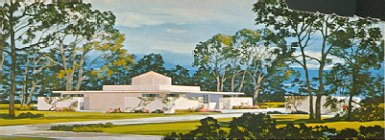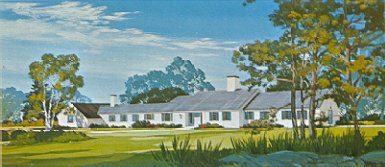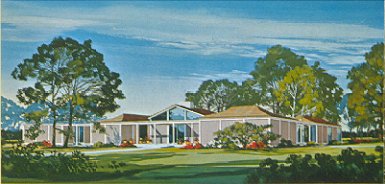|
The idea1 for "The House
of Good Taste" is said to have originated with Lady Malcolm
Douglas-Hamilton, a well-connected socialite, who mentioned it
to Thomas Deegan when seated next to him at a dinner in Greenwich,
Connecticut. She felt that a house should be exhibited that contained
traditional furniture that could be bought anywhere in the country.
Deegan (Moses' public relations man) invited Lady Hamilton to
be in charge of the design, and gave her a two acre tract just
inside the main entrance to the Fair. He also is credited with
coining the name, "The House of Good Taste."
Hamilton put together the "American
Institute of Approval," drawn from socially prominent advisors
described as "deeply interested in good taste." When
financial backers and decorators lobbied for the inclusion of
more than just a traditional house, Lady Hamilton balked, saying
"My whole concept had been a demonstration of middle-income,
middle-of-the-road, traditional American good taste. Imitation
modern can be pretentious, cheap looking, and in bad taste. The
'best' modern, or even just good 'modern', is extremely expensive
and only for the very rich." 2
She was right of course. But in the end,
The House of Good Taste became "a three-separate-home show
case for products from construction materials to cars. Architecture
will be traditional, transitional and modern. The homes will
demonstrate that attractive home living is within reach of all
Americans." 3
"Within reach of all Americans"
appears to have been somewhat relative. Nevertheless, there was
some stunning mid-20th century residential architecture and design
on display here, in what the Official Guide describes
as:
Three houses - traditional,
contemporary and modern - fully furnished and provisioned down
to liqueurs on the coffee table, ... on exhibition in this homemaker's
center. The buildings are sponsored not by one exhibitor but
by scores of building, decorating and housewares companies. Their
aim is to provide visitors with a yardstick of home building
and decorating standards.4
It was perhaps just this type of "multi-exhibitor"
pavilion that led some critics to argue that the Fair was nothing
more than a giant trade show in disguise. Indeed, not only was
The House of Good Taste privately billed in the October 29, 1963
issue of Fair News as designed "to serve as showcase
and marketing vehicle for new products in home equipment and
accessories" but (to add insult to injury) ended up charging
50 cents admission. (Other "multi-exhibitor" buildings
included Transportation and Travel, the Better Living Center,
and the Pavilion of American Interiors.) Far from detracting
from the Fair however, these installations can be seen as providing
insight into just how significant the efforts behind the giant
corporations' pavilions really were.
Leaving aside questions of appropriate
versus inappropriate self promotion, what exactly distinguished
"traditional", "contemporary" and "modern"
homes? The Official Guide described them as:
Traditional House. This house of white plastic clapboard,
with terrace and swimming pool, is an adaptation of a rambling
New England farmhouse. It has three bedrooms and displays such
features as a party room with indoor barbecue fireplace and kitchen
with a sewing nook.
Contemporary House. Sliding-glass walls and a living room
skylight make this a house of light and space. Furnishings are
both antique and contemporary, there is a separate family room,
and in the garage are a Finnish steam bath and dressing room.
Most of the rooms open onto sundecks, and the grounds have no
fewer than three pools, as well as a summer house.
Modern House. Edward Durell Stone's "inward
looking" house was designed for the suburban lot, with the
house enclosing the grounds to ensure privacy. A patio is in
each corner, and a garden is in the center under a glass dome.
The 36-foot-long living room is hung with modern American paintings
on loan from museums, galleries and artists.5
What, then, was the difference between
modern and contemporary architecture?
Historically, Modern architecture
"arose out of the rejection
of revivals, classicism, eclecticism, and indeed all adaptations
of past styles to the building types of industrializing late
19th- and 20th-century society. It also arose out of efforts
to create architectural forms and styles that would utilize and
reflect the newly available building technologies of structural
iron and steel, reinforced concrete, and glass. Until the spread
of Postmodernism, modern architecture also implied the rejection
of the applied ornament and decoration characteristic of premodern
Western buildings. The thrust of modern architecture has been
a rigorous concentration on buildings whose rhythmical arrangement
of masses and shapes states a geometric theme in light and shade."
6
Contemporary homes,
on the other hand, were those recognizable
"by their odd-sized and
often tall windows, their lack of ornamentation, and their unusual
mixtures of wall materials--stone, brick, and wood, for instance.
Architects designed Contemporary-style homes (in the Modern family)
between 1950 and 1970, and created two versions: the flat-roof
and gabled types. The latter is often characterized by exposed
beams. Both breeds tend to be one-story tall and were designed
to incorporate the surrounding landscape into their overall look."
7
Each of the three Houses of Good Taste
appeared to be an outstanding example of its style. Given the
architects involved, it could hardly have turned out otherwise.
SOURCE: Brochure,
Black & Decker Power Tools Shown at the HGT
 |
|
MODERN HOUSE
By Edward D. Stone
|
This model home achieves complete
privacy even when located in the most densely populated suburb.
A family area with a unique 22' glass dome is the center of this
design. |
|
 |
|
TRADITIONAL HOUSE
By Royal Barry Wills Assoc.
|
Offering a traditional Early American
appearance, the house boasts an attractive floor plan with well
designed rooms. |
|
 |
|
CONTEMPORARY HOUSE
By Jack Pickens Coble
|
Here the indoors and outdoors are
brought together for informal living. The unusual roof lines
and grouping of living areas attract much attention. |
|
- SOURCES (unless otherwise
indicated):
- 1Remembering
the Future, chapter 4,"The 'Laisez-Fair', Good Taste,
and Money trees: Architecture at the Fair",by Rosemarie
Haag Bletter, pp.128-29, Rizzoli International Publications Inc.,
New York, 1989.
2 Ibid, p.129.
3NY World's Fair Progress Report Number 8, April 22,
1963, p. 24.
4Official Guide New York World's Fair 1964/1965,
1964 edition, p.64, Time Incorporated, New York.
5Ibid.
6 "Modern Art." Encyclopædia Britannica.
2004. Encyclopædia Britannica Premium Service. 2 Sept.
2004 <http://www.britannica.com/eb/article?eu=54471>.
7 www.realtor.org
|